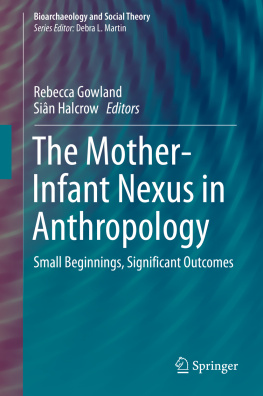First published 1963 by Transaction Publishers
Published 2017 by Routledge
2 Park Square, Milton Park, Abingdon, Oxon OX14 4RN
711 Third Avenue, New York, NY 10017, USA
Routledge is an imprint of the Taylor & Francis Group, an informa business
All rights reserved. No part of this book may be reprinted or reproduced or utilised in any form or by any electronic, mechanical, or other means, now known or hereafter invented, including photocopying and recording, or in any information storage or retrieval system, without permission in writing from the publishers.
Notice:
Product or corporate names may be trademarks or registered trademarks, and are used only for identification and explanation without intent to infringe.
Library of Congress Catalog Number: 2008001984
Newson, John, 1925-
Infant care and motherhood in an urban community / John and Elizabeth Newson.
p. cm.
Rev. ed. of: Infant care in an urban community / John Newson. 1963.
Includes bibliographical references and index.
ISBN 978-0-202-36229-8
1. ChildrenGreat Britain. 2. InfantsCare. I. Newson, Elizabeth,
1929- II. Title.
HQ792.G7N4 2008
649.1dc22
2008001984
ISBN 13: 978-0-202-36229-8 (pbk)
Acknowledgments
Many people have been concerned, directly or indirectly, in the preparation of this book and the carrying out of the investigation which it describes. Our first acknowledgment must be to the City of Nottingham Health Department, and particularly to the Medical Officer of Health, Dr William Dodd, and his staff, who most kindly put at our disposal the experience and skill of the Health Visitors. To the Health Visitors themselves we are especially grateful: it is no exaggeration to say that the survey could not have been made without their tireless and continuing help.
We are indebted to the Sir Halley Stewart Trust for their kindness in making a contribution towards the costs of production of this book.
When we tried to number the friends and colleagues who have helped us with their comments, criticism, encouragement and advice, we found that their names would fill several pages; we hope that those we do not mention here will include themselves among the many to whom we offer our thanks. To Len Chaloner, F. Le Gros Clark, Dr Ann Dally, Daisy Hogg, Mabel Holmes, Dr E. L. Loewenthal, Keith and Gillian Newson, Alison Paechter, Rosalind Palmer, Professor W. J. H. Sprott, Dr Christopher Wardle, and to others who listened patiently and argued vigorously, our warmest gratitude.
Finally, we should like to thank our children, Roger, Carey and Joanna, who are tolerant of the busyness of our life; and who, by involving us so deeply with themselves, have taught us more than we could ever otherwise have known of the complexities of infant care in an urban community.
NOTEFor obvious reasons, all names of mothers and their children have been changed, although some attempt has been made at verisimilitude: for instance, Nottingham names have been replaced by Nottingham pseudonyms, Irish by Irish, etc. Occupations given are accurate except in a very few cases where the occupation is so rare in the community that the informant might be identifiable; here a closely comparable job has been substituted. In one case certain minor details, of no significance to the content, have been altered for the sake of anonymity.
TABLES
I. Losses from the sample
II. Breakdown of total sample of 709 completed interviews
III. Percentages of mothers still breast feeding babies at various ages
IV. Proportions of mothers still breast feeding at various ages: surveys compared
V. Proportions of mothers adopting different types of feeding schedules
VI. Hours spent daily in sleep at various ages
VII. Proportions of fathers undertaking various activities in the care of one-year-olds
VIII. Classification by father's occupation
IX. Social classification of the random sample
X. Social classification of the stratified sample
XI. Analysis by social class of mother's age at first confinement and size of family
XII. Social class and the proportions of mothers aged 21 or less at the birth of their first child
XIII. Proportions of mothers undertaking relaxation exercises according to social class
XIV. Proportions of births which took place at home, according to social class
XV. Proportions of births in maternity hospital and in maternity wards of general hospitals, according to social class
XVI. Class differences in the proportions of mothers still breast feeding at different times after birth
XVII. Proportions of babies whose weaning was completed (from breast or bottle) by six months and by twelve months, according to social class
XVIII. Proportions of babies who had had a dummy at some time during the first year, and of those who still used one at twelve months: analysed by social class
XIX. Proportions of children allowed a bottle or dummy in bed, according to social class
XX. Early and late bedtimes of one-year-olds, analysed by social class
XXI. Children sleeping in a room alone, analysed by social class
XXII. Percentages of sample diets judged to be inadequate in protein or in vitamin C, analysed by social class
XXIII. Proportions ofmothers who at 12 months had not yet started toilet training; and, of babies whose training had started, proportions who had never yet used the potty for wetting: analysed by social class
XXIV. Social class and ownership of washing machines
XXV. Of mothers who report genital play in their children, proportions who attempt to prevent its occurrence; analysed by social class
XXVI. Class differences in the use of smacking at one year
XXVII. Temper tantrums and social class
XXVIII. Proportions of fathers spending an average of two or more nights a week away from home
XXIX. Couples who go out together frequently, occasionally or very rarely: analysed by social class
XXX. Participation in child care by fathers in different occupational classes
XXXI. Combined data on class differences
CONTENTS








